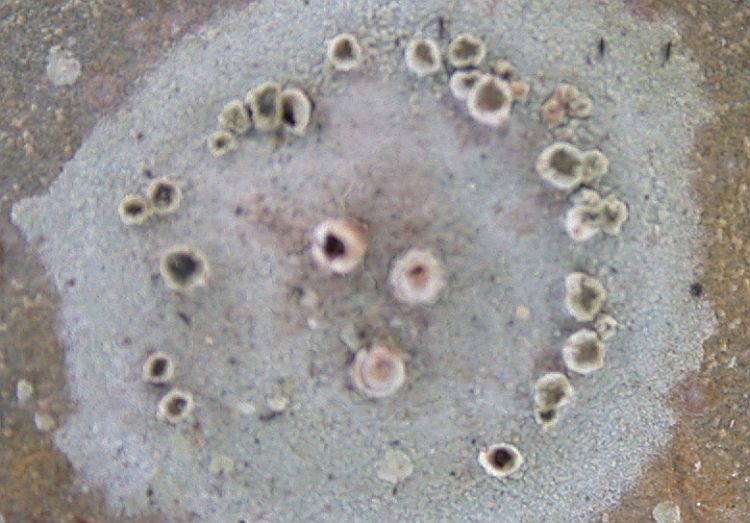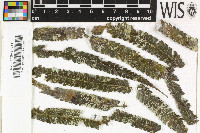
Consortium of Lichen Herbaria
- building a Global Consortium of Bryophytes and Lichens as keystones of cryptobiotic communities -
- Home
- Search
- Images
- Species Checklists
- US States: O-Z >
- US National Parks
- Central America
- South America
- US National Parks
- Southern Subpolar Region
|
|
|
|
Family: Pilocarpaceae
[Gyalectidium xantholeucum Müll.Arg.] |
Nash, T.H., Ryan, B.D., Gries, C., Bungartz, F., (eds.) 2004. Lichen Flora of the Greater Sonoran Desert Region. Vol 2. Thallus: crustose, minutely farinose and sometimes with scattered, irregular verrucae surface: typically pale bluish gray, in old specimens greenish to yellowish gray, dull photobiont: cells: globose, 5-8 µm in diam. Apothecia: sessile with biatorine margin, rounded to irregular, 0.3-0.7 mm in diam. disc: dark reddish brown to dark brown, usually thinly white to pale yellow pruinose; margin: white to pale yellow pruinose hymenium: 50-70 µm tall; hypothecium: pale to dark brown, 50-70 µm thick asci: clavate, 70-110 x 17-25 µm, 1-spored ascospores: hyaline, richly muriform, oblong-ellipsoid, 60-100 x 15-23 µm Campylidia: sessile on thallus, lobe well-developed, 0.3-0.6 mm wide, pale gray to yellow pruinose, funnel- to hood-shaped, without a distinct sockle conidia: drop-shaped, 5-8 x 1.8-2.2 µm, intermingled algal cells 3-4 µm in diam. Spot tests: all negative Secondary metabolites: pannarin, zeorin, 2,7-dichlorolichexanthone, 5,7-dichlorolichexanthone, 5,7-dichloro-3-O-methylnorlichexanthone, 5,7-dichloronorlichexanthone, 2,5,7-trichlorolichexanthone, arthothelin, isoarthothelin, asemone, 2,5,7-trichloro-3-O-methylnorlichexanthone, thiophanic acid. Substrate and ecology: on leaves in rather exposed situations in tropical and subtropical wet and moist forests World distribution: pantropical Sonoran distribution: coastal Sinaloa. Notes: Sporopodium xantholeucum is one of three species of the genus with a slightly different type of campylidia, in being more funnel- to hood-shaped and lacking a basal sockle, but having an internal hemispherical bulge instead and apical periphysoids. The other neotropical species featuring this type of campylidia, S. aeruginascens, is distinguished by dense, irregularly papillose thallus verrucae, bright yellow campylidia, and a different chemistry, while the African S. podosphaerum has a greenish gray thallus, gray campylidia, and 1-septate conidia. The apothecial anatomy is rather similar in all three species. Apart from a different campylidial type and different chemistry, other neotropical species of the genus with bluish gray thallus campylidia, S. pilocarpoides also has a verrucose, more and pruinose apothecia are distinguished as follows: S. greenish gray thallus, and S. phyllocharis has regularly citrinum has a densely verrucose thallus and bright yellow rounded apothecia. |
Powered by Symbiota





















